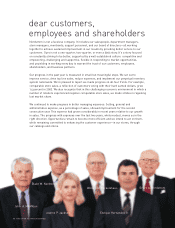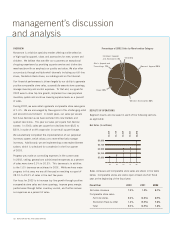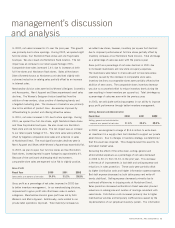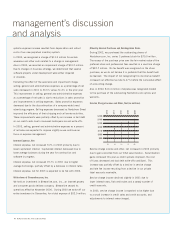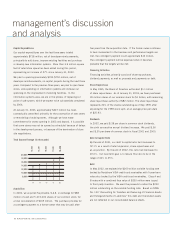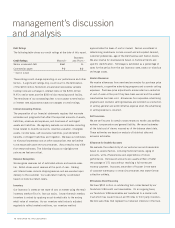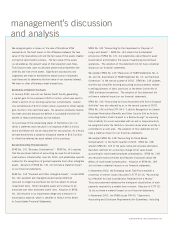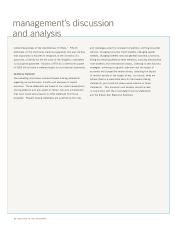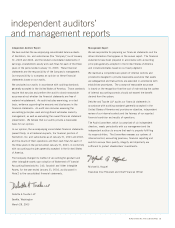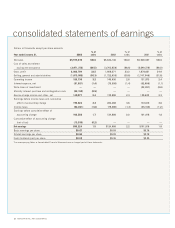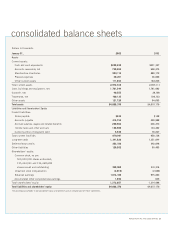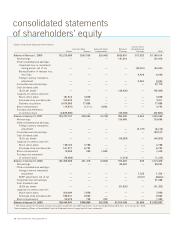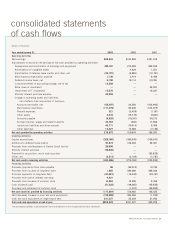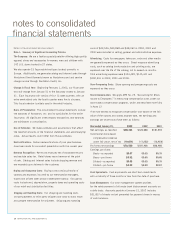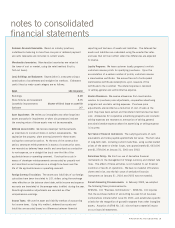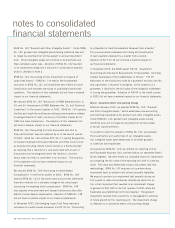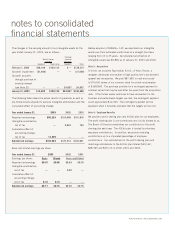Nordstrom 2002 Annual Report Download - page 21
Download and view the complete annual report
Please find page 21 of the 2002 Nordstrom annual report below. You can navigate through the pages in the report by either clicking on the pages listed below, or by using the keyword search tool below to find specific information within the annual report.
management’s discussion
and analysis
NORDSTROM INC. AND SUBSIDIARIES 19
We recognize gains or losses on the sale of Nordstrom VISA
receivables to the trust based on the difference between the face
value of the receivables sold and the fair value of the assets created
during the securitization process. The fair value of the assets
is calculated as the present value of their expected cash flows.
The discount rates used to calculate present value represent the
volatility and risk of the assets. Significant assumptions and
judgments are made to estimate the present value of expected
cash flows and to determine the fair value of our retained interest.
We have no other off-balance sheet transactions.
Realization of Deferred Tax Assets
In January 2003, we sold our Denver Credit facility generating
a capital gain for tax purposes of $15.4 million, which was used to
offset a portion of our existing capital loss carryforwards. Capital
loss carryforwards of $19.0 million remain available to offset capital
gain income in the next three years. No valuation allowance reserve
has been provided because we believe it is probable that the full
benefit of these carryforwards will be realized.
Our purchase of the outstanding shares of Nordstrom.com, Inc.
series C preferred stock resulted in an expense of $40.4 million
which we believe will not be deductible for tax purposes. As a result,
we have established a valuation allowance reserve of $16.5 million
to offset the deferred tax asset related to this purchase.
Recent Accounting Pronouncements
SFAS No. 141 “Business Combinations” - SFAS No. 141 requires
that the purchase method of accounting be used for all business
combinations initiated after June 30, 2001, and establishes specific
criteria for the recognition of goodwill separate from other intangible
assets. Adoption of SFAS No. 141 did not have a material impact
on our financial statements.
SFAS No. 142 “Goodwill and Other Intangible Assets” - Under SFAS
No. 142, goodwill and intangible assets having indefinite
lives will no longer be amortized but will be subject to annual
impairment tests. Other intangible assets will continue to be
amortized over their estimated useful lives. Adoption of SFAS
No. 142 resulted in an impairment charge and a reduction in
amortization expense, which is detailed in Note 2 of the Notes
to Consolidated Financial Statements.
SFAS No. 144 “Accounting for the Impairment or Disposal of
Long-Lived Assets” - SFAS No. 144 retains the fundamental
provisions of SFAS No. 121, but establishes new criteria for asset
classification and broadens the scope of qualifying discontinued
operations. The adoption of this statement did not have a material
impact on our financial statements.
We adopted SFAS No. 145 “Rescission of FASB Statements No. 4,
44, and 64, Amendment of FASB Statement No. 13, and Technical
Corrections” in the second quarter of 2002. SFAS No. 145 updates,
clarifies and simplifies existing accounting pronouncements related
to extinguishments of debt, provisions of the Motor Carrier Act of
1980 and lease transactions. The adoption of this statement did
not have a material impact on our financial statements.
SFAS No. 146 “Accounting for Costs Associated with Exit or Disposal
Activities” was also adopted by us in the second quarter of 2002.
SFAS No. 146 nullifies EITF 94-3 “Liability Recognition for Certain
Employee Termination Benefits and Other Costs to Exit an Activity
(including Certain Costs Incurred in a Restructuring)” by requiring
that a liability for a cost associated with an exit or disposal activity
be recognized when the liability is incurred versus when an entity is
committed to an exit plan. The adoption of this statement did not
have a material impact on our financial statements.
We adopted SFAS No. 148 “Accounting for Stock-Based
Compensation” in the fourth quarter of 2002. SFAS No. 148
amends SFAS No. 123 of the same name and provides alternative
transition methods for a voluntary change to fair value based
accounting for stock-based employee compensation. SFAS No. 148
also requires more prominent and frequent disclosures about the
effects of stock-based compensation. Adoption of SFAS No. 148
did not have a material impact on our financial statements.
In November 2002, the Emerging Issues Task Force reached a
consensus on certain issues discussed in EITF 02-16, “Accounting
by a Reseller for Cash Consideration Received from a Vendor.”
This pronouncement addresses the timing and classification of cash
payments received by a reseller from a vendor. Adoption of EITF 02-
16 did not have a material impact on our financial statements.
In November 2002, the FASB issued FIN 45, “Guarantor’s
Accounting and Disclosure Requirements for Guarantees, Including



